The VAEEC wouldn’t be able to accomplish all that we do without extra helping hands. We wanted to take a moment to introduce our membership to our stellar group of interns helping us out this summer and to thank them for a job well done.
Mariah Davis
Events and Social Media
 Many of you met Mariah Davis, our Events and Social Media Intern, at the spring meeting at University of Richmond back in May. She has been helping out at VAEEC headquarters since February 2016. Mariah received her B.S. in Environmental Studies from Virginia Commonwealth University in 2013. She currently splits her time between the Virginia Energy Efficiency Council and the Virginia Conservation Network where she actively engages in stakeholder processes to advance clean water and clean energy policies in Virginia. Her other interests include grassroots advocacy and advancing environmental justice for underrepresented communities. Email Mariah.
Many of you met Mariah Davis, our Events and Social Media Intern, at the spring meeting at University of Richmond back in May. She has been helping out at VAEEC headquarters since February 2016. Mariah received her B.S. in Environmental Studies from Virginia Commonwealth University in 2013. She currently splits her time between the Virginia Energy Efficiency Council and the Virginia Conservation Network where she actively engages in stakeholder processes to advance clean water and clean energy policies in Virginia. Her other interests include grassroots advocacy and advancing environmental justice for underrepresented communities. Email Mariah.
Kelsey Galantich
Census
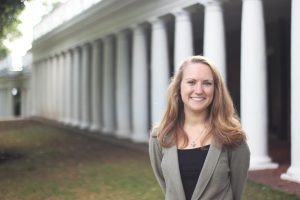 Kelsey Galantich is one of VAEEC’s Census Interns who is doing the very important work of building our list of companies in Virginia who create jobs in the energy efficiency sector as she helps us tackle the Clean Energy Census. As a recent graduate of the University of Virginia, Kelsey has completed a double major in Global Environments & Sustainability and French Language & Literature. She will be teaching English in French Guiana in the Fall and hopes to eventually practice international environmental law with a focus on energy policy. Email Kelsey.
Kelsey Galantich is one of VAEEC’s Census Interns who is doing the very important work of building our list of companies in Virginia who create jobs in the energy efficiency sector as she helps us tackle the Clean Energy Census. As a recent graduate of the University of Virginia, Kelsey has completed a double major in Global Environments & Sustainability and French Language & Literature. She will be teaching English in French Guiana in the Fall and hopes to eventually practice international environmental law with a focus on energy policy. Email Kelsey.
Diana McDermott
Census
 Diana McDermott, another Census Intern, is a Junior studying Economics at Virginia Tech. After participating in the Virginia Tech Sustainability Institute Cohort, Diana became interested in environmental issues and discourse. She will be continuing to study economics with a minor in entrepreneurship in hopes of starting an energy auditing company and small business consultation in energy consumption. Email Diana.
Diana McDermott, another Census Intern, is a Junior studying Economics at Virginia Tech. After participating in the Virginia Tech Sustainability Institute Cohort, Diana became interested in environmental issues and discourse. She will be continuing to study economics with a minor in entrepreneurship in hopes of starting an energy auditing company and small business consultation in energy consumption. Email Diana.
If you cross paths when any of our wonderful interns, I hope that you will take a moment to thank them for their invaluable work for the VAEEC.
Thank you to our many members for their continued support of the Virginia Energy Efficiency Council! We could not have accomplished so much over the past year without it. Membership dues enabled us to:
- Give members access to timely and relevant resources on energy efficiency. Our easier-to-navigate website (complete with new logo) and a monthly e-newsletter enables us to be the go-to resource for credible information on energy efficiency in the Commonwealth.
- Contribute to the policy conversation that will impact Virginia’s utility energy efficiency programs. The VAEEC submitted comments to the State Corporation Commission in response to their request for input on evaluating the creation of protocols to measure the impact of utility energy efficiency programs. You can view our comments and those of several of our members here.
- Bring greater awareness to state elected officials on energy efficiency benefits through our co-sponsorship of Clean Energy Lobby Day.
Members: Your continued support will have an important impact on advancing policies and programs in Virginia to grow energy efficiency endeavors across the Commonwealth.
Some of our biggest goals over the next 12 months include:
- Hosting our first annual awards ceremony in the fall – as part of our well-attended biannual meetings — to highlight energy efficiency champions in the Commonwealth.
- Responding to member requests by initiating new opportunities like a webinar series.
- Supporting the Governor’s Executive Committee on Energy Efficiency’s work to meet our state’s goal of reducing energy consumption 10% by 2020.
- Advancing commercial PACE in Virginia localities.
New in 2016, we have added a Business Platinum membership level starting at $2,000 that has exclusive benefits. We have also adjusted the Business Gold membership level to $1,000 to bring it more in-line with the Business Silver and Platinum dues.
The next 12 months will be critical to our work – work that we cannot do without your help. Please renew your membership today.
(June 28, 2016) Governor McAuliffe today issued Executive Order 57 directing Virginia Secretary of Natural Resources Molly Ward to convene a workgroup and recommend concrete steps to reduce carbon pollution from Virginia’s power plants. The group will evaluate options under Virginia’s existing authority to address carbon pollution. You can read the Governor’s press release here.
The following is the statement of Chelsea Harnish, VAEEC Executive Director:
“The Virginia Energy Efficiency Council applauds Governor McAuliffe’s announcement today on issuing Executive Order 57. Any plan to reduce carbon emissions should include strong energy efficiency policies. The Governor has been a champion of energy efficiency since taking office, which has been exemplified by his action to initiate the first-ever Governor’s Executive Committee on Energy Efficiency. Energy efficiency creates jobs, saves families and businesses money, and helps reduce pollution and carbon emissions — all benefits that the Commonwealth deserves from economic, energy and environmental initiatives like Executive Order 57.”
About the Virginia Energy Efficiency Council
The Virginia Energy Efficiency Council is a 501(c)3 organization seeking to provide a forum for stakeholder interaction and to assess and support programs, innovation, best practices, and policies that advance energy efficiency in Virginia.
By Cynthia Adams, VAEEC Board Chair
Utility programs are evaluated based on a number of metrics: cost, energy saved, impact on capacity or peak load, and public interest benefits to name a few germane to Virginia regulators. How one measures the effectiveness of utility programs – or answers the question “Did ratepayers get their money’s worth?” – is a very important question upon which millions of dollars and Btu’s saved depend.
Recently the VAEEC submitted comments in response to the State 
Corporation Commission’s request for input on evaluating the establishment of protocols, a methodology, and a formula to program the impact of energy efficiency measures (Evaluation, Measurement & Verification or EM&V). So did many other groups, businesses, and individuals (we’ve catalogued many of them here) – and for good reason.
Energy efficiency, which includes demand response, is a “keep the lights on” resource, but only in the sense that it can reduce load such that the lights don’t go off in the first place due to a peak event. We don’t “generate” energy efficiency as a resource in the same way as a power plant, and so, without EM&V, how do we know that the EE was ever implemented or dispatched? EM&V is the performance check that ultimately correlates a decrease in energy use due to the implementation of a certain energy efficient measure(s). We measure and verify in order to evaluate the effectiveness of programs.
While this basic concept may seem straightforward, there are complexities to doing EM&V well that are very important to get right. In Virginia, we don’t yet have an official EM&V protocol, much less standards that apply to all utilities in the same way. Currently, utilities hire a professional consultant to perform EM&V and then report on results to the SCC. This memo from Energy Synapse Economics is a good overview of EM&V in Virginia.
SCC staff will issue their own report with recommendations on June 24th, and a public hearing will be held on July 12th. I will be at the hearing to represent the VAEEC, and other members of the VAEEC and Board will attend to represent their constituencies.
With the U.S. EPA’s Clean Power Plan on the horizon, the state’s voluntary energy efficiency goal looming large, and untold killowatts (and money) wasted daily in inefficient buildings – the VAEEC is very interested in the outcome of this hearing.
A sound, cost-effective, and transparent EM&V process can help get the naysayers past “believing” in the value of energy efficiency to the Commonwealth and instead, seeing the value in dollars and good sense.
Cynthia Adams serves at VAEEC Board Chair and is CEO of Pearl Certification a VAEEC Business Silver Member
How many jobs does the clean energy (including energy efficiency) industry support in Virginia and the Southeast? What types of jobs? At how many different companies? And with what type of revenue? What challenges are standing in the way?
Those are questions we get asked by policy and decision makers all the time. And we need your help as VAEEC members and stakeholders to answer them.
Please respond to a survey conducted during the summer of 2016 as part of the Southeast Clean Energy Industry Census. This four-state project, implemented by the North Carolina Sustainable Energy Association (NCSEA), documents trends and changes within the clean energy industry in order to demonstrate to decision makers where regulation and policy are achieving a successful marketplace.
What is the Census?
Every year since 2008, the NCSEA has conducted a census of all 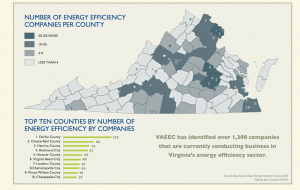 businesses and activities both directly and indirectly related to the clean energy sector. It was expanded in 2013 to also include South Carolina, Georgia, and Virginia, allowing for a more comprehensive picture of the energy economy of the Southeast. The Virginia Energy Efficiency Council is responsible for the Virginia portion of the census, and has expanded the list to include all businesses that operate within the energy efficiency sector.
businesses and activities both directly and indirectly related to the clean energy sector. It was expanded in 2013 to also include South Carolina, Georgia, and Virginia, allowing for a more comprehensive picture of the energy economy of the Southeast. The Virginia Energy Efficiency Council is responsible for the Virginia portion of the census, and has expanded the list to include all businesses that operate within the energy efficiency sector.
You can download the 2013 Virginia Census Report.
Why is it important?
The census allows us to benchmark the overall clean energy industry and specific sectors, to share with legislators the impact clean energy is having on both the state and local economy, to connect with current and potential members about their work, to share the success story of clean energy with news media, and to identify where policy changes are affecting the marketplace over time.
How the Census works
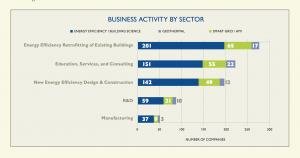 All businesses will be sent a survey via email, which is conducted in complete confidentiality in order to receive the most accurate and direct responses possible. In the survey, each business will be asked questions regarding company details (e.g., name, address, primary contact), clean energy activities performed, clean energy sectors in which the business is active, revenue, full-time jobs offered by the clean energy activity/sector, and areas in which the company does business. The survey is considered complete if businesses include responses to all of the aforementioned topics. The survey will be posted online, and will be open through September 20, 2016. If we haven’t heard back from your company, you will be contacted by phone in June and July by an outside contractor, and follow-up interviews with non-respondents will be conducted in September. The survey, based on a sample pool of approximately 3,800 firms, aims to obtain a minimum of 1,600 completions by phone or online.
All businesses will be sent a survey via email, which is conducted in complete confidentiality in order to receive the most accurate and direct responses possible. In the survey, each business will be asked questions regarding company details (e.g., name, address, primary contact), clean energy activities performed, clean energy sectors in which the business is active, revenue, full-time jobs offered by the clean energy activity/sector, and areas in which the company does business. The survey is considered complete if businesses include responses to all of the aforementioned topics. The survey will be posted online, and will be open through September 20, 2016. If we haven’t heard back from your company, you will be contacted by phone in June and July by an outside contractor, and follow-up interviews with non-respondents will be conducted in September. The survey, based on a sample pool of approximately 3,800 firms, aims to obtain a minimum of 1,600 completions by phone or online.
By completing this survey, each business helps us create an accurate analysis of the economic impact of clean energy, to demonstrate the effects of policy changes on the industry over time, and to build a network of resources that are invaluable to national-level partners.
Effectively, this survey will help to not only shape the future of the energy industry in Virginia and the Southeast, but also future policy changes for the entire country. In order to create the most informative list possible, it is imperative that all businesses give detailed and complete responses in order to paint a vivid picture of the dynamic and exciting clean energy industry.
If you have any questions, please contact us at info@vaeec.org.
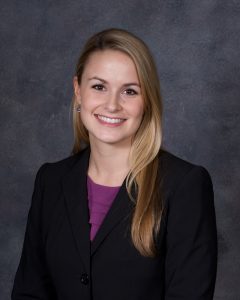 Guest Post by: Stuart Nuckols, Viridiant (Associate Member)
Guest Post by: Stuart Nuckols, Viridiant (Associate Member)
The American Council for an Energy Efficient Economy’s (ACEEE) 2015 State Energy Efficiency Scorecard[1] ranks Virginia 31st in the country for Energy Efficient Programs and Policies. While this may be discouraging to organizations and businesses invested in making the Commonwealth more energy efficient, there is positive energy efficiency policy news to share.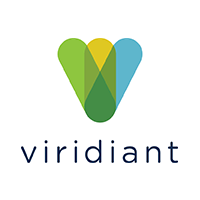
In the last 10 years, Virginia Housing Development Authority (VHDA) and Viridiant, formerly EarthCraft Virginia, have made tremendous progress to successfully implement energy efficiency measures in low income, affordable housing.
Beginning in 2007, VHDA implemented an incentive in the Low-Income Housing Tax Credit (LIHTC) program that encouraged developers to pursue a recognized third-party standard, including Viridiant’s EarthCraft Multifamily program. This successful partnership has resulted in over 230 developments representing more than 16,000 certified apartments in Virginia.
With a substantial number of developments pursuing energy efficient construction, there was an interest in understanding the efficacy of VHDA’s policy decision to promote energy efficient construction in the Virginia rental housing stock. After initial funding from VHDA to benchmark and track unit-level performance of four EarthCraft Multifamily certified projects that had utilized Low Income Housing Tax Credits brought exciting findings, Viridiant partnered with Housing Virginia and the Virginia Center for Housing Research (VCHR) at Virginia Tech to publish a first-of-its-kind study that demonstrates the impact of energy efficient incentives in the construction of affordable rental housing in Virginia.
The 2015 report, The Impact of Energy Efficient Design and Construction on LIHTC Housing in Virginia[2], shows that the average EarthCraft Multifamily apartment reduces monthly energy consumption by 464 kilowatt hours saving $54/month on electricity, which amounts to annual savings of $648 and 5,568 kilowatt hours.
In addition to the energy and utility cost analysis, the research team deployed an anonymous survey to residents to gain insight into housing satisfaction, comfort, thermostat set points, appliance use, etc. In general, residents sampled in the study were more satisfied, more comfortable and paid lower utility costs compared to previous housing. An unanticipated finding of the study was the value observed in the independent, third party verification process that was instrumental in helping development teams achieve their energy and sustainability goals.
The study is one of the first in the nation to evaluate unit-level electricity consumption of affordable apartments built to exceed current efficiency standards. Of the 230 EarthCraft Certified Multifamily projects, 15 projects were selected to ensure representation of building type, geographic location, resident population and both new construction and renovation. Using actual utility performance, unit-level energy projection models, building information, and resident surveys, the team concluded that, on average, units performed 16.6% better than Viridiant had modeled, outperforming standard construction by 30%.
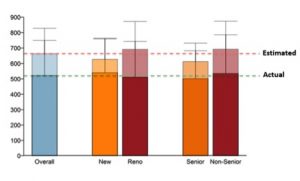
Figure 1: Monthly averages for estimated energy consumption (energy model) vs. observed energy consumption in certified EarthCraft Multifamily projects.
With savings reported in this study at almost $650 a year on average and over 16,000 EarthCraft Multifamily dwelling units in Virginia, the projects have the potential to save residents over $10 million in 2016 alone.
A continuation of the study is underway to assess construction costs of energy efficient construction and scheduled to be released in 2017.
About Viridiant
Viridiant will continue to support the industry with the EarthCraft family of green building programs, but the organization is also looking to broaden its reach and mission. Recently rebranded as Viridiant, the organization plans to add more services and certifications in areas such as in-home energy monitoring, utility allowances, online energy assessment tools and unbiased consultation on specialties such as solar energy and energy-efficient home mortgages.
The new name, which is derived from a combination of “viridis,” the Latin word for “green,” and “-ant” of “servant” for their mission-driven stewardship, recognizes the group’s expansion into Washington, D.C. and Maryland, and its intention to do more to demonstrate how the latest building science can set a path for businesses and homeowners to create structures that are more affordable, livable and durable.
Viridiant offers win-win solutions for anyone who is interested in living in or building better buildings. “From net-zero to environmental sustainability and improved air quality, we are well versed in helping our partners exceed their goals to deliver high quality products and avoid construction pitfalls,” said KC Bleile, Viridiant’s Executive Director. “Having served nearly 20,000 families and 325 building partners, we’re excited to use what we’ve learned to expand our programs and reach to serve twice as many families over the next ten years.”
Over the coming months, Viridiant will begin to pilot, test and launch new programs and services to serve their broader goals.
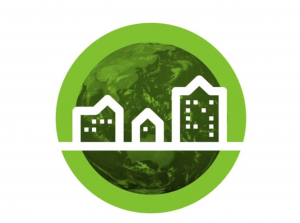 Find out how their new name embodies the vision for their organization in this video.
Find out how their new name embodies the vision for their organization in this video.
[1] http://aceee.org/state-policy/scorecard
[2]Virginia Center for Housing Research (VCHR), Virginia Tech, 2015. The Impact of Energy Efficient Design and Construction on LIHTC Housing in Virginia, Contract Report submitted to Housing Virginia, Richmond, VA. Retrieved January 15, 2016, from http://www.vchr.vt.edu/wp-content/uploads/2015/02/Housing-VA-LIHTC-Study-Full-Report.pdf
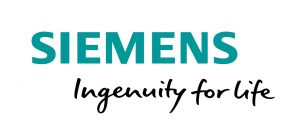 For over 165 years, Siemens has built a reputation for delivering leading-edge products and services, high levels of customer satisfaction, and an unending spirit of innovation. As a $100B company with over 370,000 employees in 190 countries, Siemens is a global powerhouse in electronics and electrical engineering, industry, energy, healthcare, infrastructure, and building automation.
For over 165 years, Siemens has built a reputation for delivering leading-edge products and services, high levels of customer satisfaction, and an unending spirit of innovation. As a $100B company with over 370,000 employees in 190 countries, Siemens is a global powerhouse in electronics and electrical engineering, industry, energy, healthcare, infrastructure, and building automation.
From initial assessment through ongoing support, the Building Technologies Division of Siemens Industry, Inc. is the world market leader for safe, reliable, energy-efficient, and sustainable buildings and infrastructures. As a service provider, system integrator, and product manufacturer, Siemens offers sustainable building products, technologies, and solutions that help optimize building automation, fire safety and security systems, HVAC, air quality, power distribution and management, and energy efficiency. Our systems, services, resources, and experience help ensure facilities are safe, efficient, and compliant.
As a true full-service energy services company (ESCO), Siemens provides the industry’s most comprehensive end-to-end energy solutions – from energy reduction to production and procurement – enabling cities to best achieve energy and water goals while positively impacting the economy and environment. Siemens extensive expertise in guaranteed performance-based solutions, combined with our scalable, proven portfolio, allows us to most efficiently and effectively meet the needs of all communities, including small-, medium-, and large-sized cites.
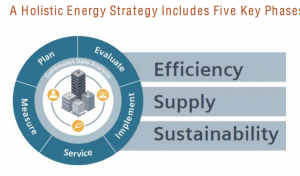
Siemens Commissioning Advantage Program (CxA) is a comprehensive building energy and performance optimization program designed to improve the way facility mangers operate their facilities. This program includes a variety of individual offerings that have a far greater impact when combined as a holistic solution.
Siemens’ white paper, “Commissioning: An Essential Part of a Comprehensive Energy Strategy,” talks about how and why Commissioning should be included in a company’s energy plan. Here is an excerpt from that white paper:
“Through proper assessment and planning, a comprehensive energy strategy that includes commissioning will serve as a roadmap to maximize building performance. A fragmented approach to commissioning can compromise the long-term health of the building; it is important to integrate commissioning into a facility’s energy management strategy. Depending on the building’s level of energy-efficiency, age, and use, the commissioning approach will be comprised of both one-time initiatives and ongoing services, and both are designed to reduce energy costs while enabling continuous performance improvements.”
A Holistic Energy Strategy Includes Five Key Phases
- Strategy & Planning
- Evaluation & Assessment
- Program Implementation
- Ongoing Services & Optimization
- Measurement & Reporting
Learn more at www.usa.siemens.com/commissioning or contact:
Janet S. Tribble
Siemens Industry, Inc.
Building Technologies Division
Business Development, Building Performance & Sustainability
janet.tribble@siemens.com
804-426-1980
We enjoyed the spring meeting last week and hope that you did too. We received many positive remarks on the venue, so we may just have to hold another event at the University of Richmond Jepson Center.
In case you missed it, below are some highlights from the day and links to download the presentations. You can also see photos on our Facebook page — be sure to tag yourself and your colleagues.
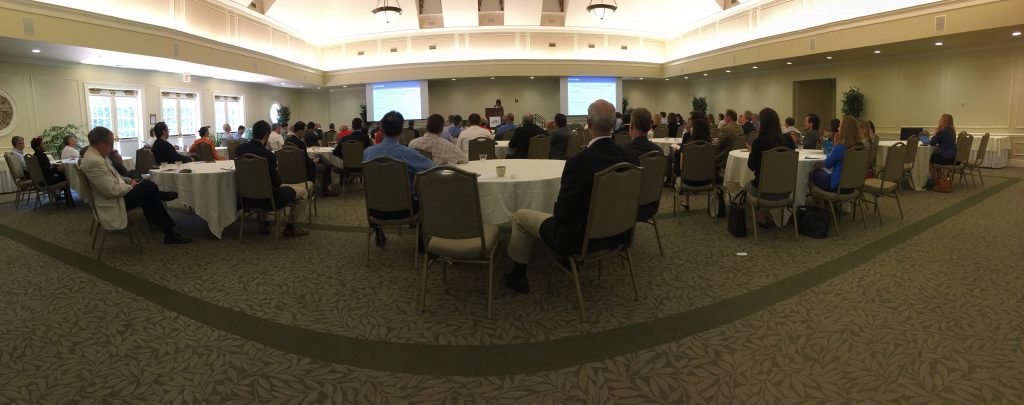
To kick off the event, we unveiled a new logo and website! This took many hours of hard work, and we are pleased with the end result. I hope you will check out the rest of the site while you’re here.
I also ran through some of the key data from the member survey. It’s very clear that you, our members, enjoy being part of a broad coalition that is driving energy efficiency policy and programs in Virginia.
We received positive feedback on our communications and potential new member-only benefits. We also heard that you want more networking and training opportunities such as webinars, so later this month we’ll launch our webinar series. We asked and you answered so the first webinar topic will be on PACE financing. The date is set for June 30 at noon. Details will follow soon.
The VAEEC membership also reappointed 3 of our board members and voted on two new members to expand the board to 13. You can see all of our board members here.
After my remarks, Hayes Framme, from the office of Governor McAuliffe, 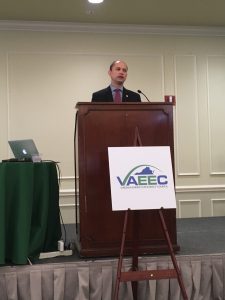 gave an update on the 2016 General Assembly session and the work of the Governor’s Executive Committee on Energy Efficiency (GEC). Hayes told the crowded room about SB 395 and HB 1053, which were bills the Governor initiated. The final outcome for these bills, which wasn’t the initially hoped for outcome (as detailed here), directed the State Corporation Commission to open a public comment period in order to draft a response on the feasibility of developing protocols to verify savings of utility programs. The VAEEC supported these bills during session and our full comments to the SCC can be found here.
gave an update on the 2016 General Assembly session and the work of the Governor’s Executive Committee on Energy Efficiency (GEC). Hayes told the crowded room about SB 395 and HB 1053, which were bills the Governor initiated. The final outcome for these bills, which wasn’t the initially hoped for outcome (as detailed here), directed the State Corporation Commission to open a public comment period in order to draft a response on the feasibility of developing protocols to verify savings of utility programs. The VAEEC supported these bills during session and our full comments to the SCC can be found here.
Hayes also discussed the GEC itself, for which we have a dedicated page on our website as we are a partner of the state energy office in providing support to the GEC’s work.
Next up was John Morrill with Arlington County to discuss the progress of the DEQ stakeholder group that is helping DEQ identify the commonwealth’s compliance path for the Clean Power Plan. John mentioned that consensus was hard to come by among the stakeholders, but more importantly, consensus was reached that all stakeholders like pie. Details were not shared on which kind.
Following the lunch networking break, we picked the agenda back up with 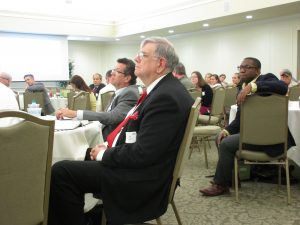 three more presentations. First was Ryan Hodum with David Gardiner & Associates — also our newest member! Ryan presented on two of DGA’s initiatives: Chambers of Innovation for Clean Energy, a program that is engaging local Chambers of Commerce on clean energy issues, and the Alliance for Industrial Efficiency, which which focuses on state and federal industrial energy efficiency policy, primarily on combined heat and power.
three more presentations. First was Ryan Hodum with David Gardiner & Associates — also our newest member! Ryan presented on two of DGA’s initiatives: Chambers of Innovation for Clean Energy, a program that is engaging local Chambers of Commerce on clean energy issues, and the Alliance for Industrial Efficiency, which which focuses on state and federal industrial energy efficiency policy, primarily on combined heat and power.
Next, was the Featured Member of the month. For May, we featured, Pearl Certification. Cynthia Adams, VAEEC’s board chair is CEO of this new company, which helps homeowners save money through energy savings but also helping them recapture some of the value of their home improvement investment if they decide to sell later on.
Our final presentation of the day was by Zack Miller with Virginia Housing Alliance who discussed the initiatives of the Multifamily Energy Efficiency Coalition (MFEEC). Multifamily housing accounts for 12% of Virginia’s total housing stock, equal to 385,000 units. These residences are typically left out of energy efficiency programs, so the coalition is working to advance policies that provide comprehensive energy efficiency services to this sector. The VAEEC and many of our members are proud to be part of this worthwhile initiative.
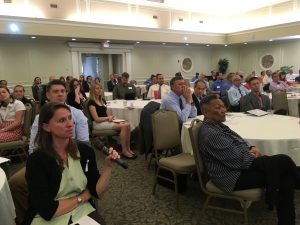 We spent the last 30 minutes of the meeting giving our members the opportunity to brag a little bit. A microphone was sent around for members to give a 2-3 minute update on anything they are working on related to energy efficiency. Dominion Virginia Power, Columbia Gas and Washington Gas all gave updates on their energy efficiency programs and their latest proceedings before the SCC. Several other members gave updates as well including Trane, Viridant, Virginia Community Capital, and Loudon County Public Schools. We are pleased that so many members chimed in to talk about their work.
We spent the last 30 minutes of the meeting giving our members the opportunity to brag a little bit. A microphone was sent around for members to give a 2-3 minute update on anything they are working on related to energy efficiency. Dominion Virginia Power, Columbia Gas and Washington Gas all gave updates on their energy efficiency programs and their latest proceedings before the SCC. Several other members gave updates as well including Trane, Viridant, Virginia Community Capital, and Loudon County Public Schools. We are pleased that so many members chimed in to talk about their work.
Our next member meeting will take place in November where we will hold our first annual Energy Efficiency Champions awards ceremony. Stay tuned for details.
Links to Presentations:
General Assembly Recap and Governor’s Executive Committee on Energy Efficiency Update (Hayes Framme: Virginia’s Chief Energy Efficiency Officer)
Clean Power Plan Update (John Morill: Energy Manager for Arlington County, VAEEC Goverance Board and member of the Governor’s Clean Power Plan Stakeholder Group)
Chambers of Innovation (Ryan Hodum: Vice President, David Gardiner and Associates)
Member Spotlight (Cynthia Adams: Pearl Certification)
Multifamily Housing Coalition Update (Zack Miller: Policy Director, Virginia Housing Alliance)
May 2016
Pearl National Home Certification
Business Silver Member
Pearl National Home Certification is a Virginia-based startup launched in 2015. Pearl is dedicated to increasing the energy efficiency and comfort of existing homes and will transform the market by helping homeowners capture the value of their home energy upgrades for resale or refinance. Network contractors and real estate agents grow their businesses when they become Pearl Partners by providing their clients access to Pearl’s special services, such as exclusive rebates and lending products, and a “My Home Profile” account to track progress towards certification.
At the helm are Co-Founders Cynthia Adams, also founder and President of the VAEEC and formerly the Executive Director of the Local Energy Alliance Program; and Robin LeBaron, formerly Managing Director of the National Home Performance Council. Pearl is an official partner with the Department of Energy’s Home Performance with ENERGY STAR program, running pilots in central and northern Virginia.
How Does Pearl Work?
 Pearl’s certification service is used by contractors to verify and score a home’s energy assets for certification. When a home’s features earn it enough points, Pearl issues a BRONZE, SLIVER, GOLD, or Net Zero certificate and Home Energy Asset Inventory report. Real estate agents use Pearl’s services to help sellers market their energy efficient home and to help buyers maintain and improve their “new” home through an exclusive “My Home Profile” account. “My Home Profile” provides homeowners with a plan to achieve certification, as well as online resources for maintaining their home. Pearl’s software also functions like a virtual general contractor, helping homeowners find contractors to make improvements and tracking progress made over time.
Pearl’s certification service is used by contractors to verify and score a home’s energy assets for certification. When a home’s features earn it enough points, Pearl issues a BRONZE, SLIVER, GOLD, or Net Zero certificate and Home Energy Asset Inventory report. Real estate agents use Pearl’s services to help sellers market their energy efficient home and to help buyers maintain and improve their “new” home through an exclusive “My Home Profile” account. “My Home Profile” provides homeowners with a plan to achieve certification, as well as online resources for maintaining their home. Pearl’s software also functions like a virtual general contractor, helping homeowners find contractors to make improvements and tracking progress made over time.
Why Homeowners Sign Up with Pearl
Pearl offers homeowners:
- An initial estimate of the home’s certification level through a free My Home Profile account
- Information on rebates and loans to help pay for energy, health and other home improvements
- Access to a network of high-quality, specially trained Pearl-Approved Contractors
- Certification of a home’s energy efficient and health features
- Documentation and marketing services to help sell a certified home
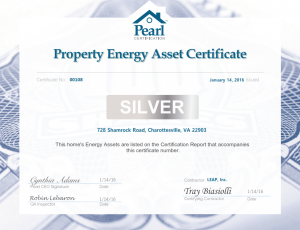 Interested homeowners who want to sign up for Pearl can do so here: www.yourhomeprofile.com.
Interested homeowners who want to sign up for Pearl can do so here: www.yourhomeprofile.com.
You can check out a sample certification report here.
How Contractors Benefit with Pearl
Pearl’s software provides quality contractors a marketing and certification system to enhance home performance and energy efficiency sales. Network contractor benefits include:
- Client engagement from the first appointment on
- Increased job size through certification services
- Relationship marketing through Pearl’s email services
- Homeowner referrals from Pearl Partners
- Differentiation from low bid/low quality competitors
This list of benefits results in increased revenue for contractors: the average insulation sales person can generate over $100K in additional yearly sales with Pearl, and the average HVAC sales person double that number. To learn more about how contractors can grow their business with Pearl, visit www.pearlcertification.com/contractor.
How Real Estate Agents Benefit with Pearl
Realtors have been among Pearl’s earliest and strongest partners, given the mutual interest in helping home buyers create value, and sellers access it.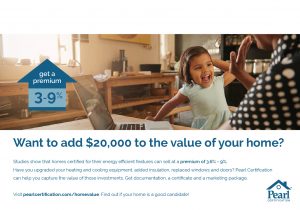
The National Association of Home Builders found that nine out of ten buyers would rather purchase a home with energy-efficient features, and would be willing to pay more for it. A recent study by the Appraisal Institute and the Institute for Market Transformation found that Washington, D.C. homes that were certified energy efficient sold for a 3.6% price premium. It’s representative of what we’re seeing across markets in the U.S. where, on average, third party certified homes are selling for 4-5% higher. On a $500K home, this can be $25K in added value sellers are currently leaving on the table.
As a Pearl Partner, real estate agents get:
- Buyer’s closing gift of a Pearl “My Home Profile” account
- Monthly client emails with informative and timely maintenance tips
- Training on selling the energy efficient home
- Special certification report package and other marketing tools for selling the certified home
- Client referrals from our Pearl Network contractors
 Real estate agents interested in learning more should visit pearlcertification.com/homevalue/
Real estate agents interested in learning more should visit pearlcertification.com/homevalue/
We’ve got a great agenda lined up for the May 26th VAEEC meeting, including a presentation by Ryan Hodum of David Gardiner and Associates about Chambers for Innovation and Clean Energy (CICE), a national clean energy information hub and network for local chambers of commerce.
 Created and led by local chambers of commerce, CICE helps fellow chambers and their member companies navigate and prosper in the clean energy and innovation spaces. CICE shares best practices and case studies, connects chambers with sought-after experts and high-level decision makers, promotes the clean energy work being done by local chambers, and helps chambers find incentives and financing for new clean energy initiatives.
Created and led by local chambers of commerce, CICE helps fellow chambers and their member companies navigate and prosper in the clean energy and innovation spaces. CICE shares best practices and case studies, connects chambers with sought-after experts and high-level decision makers, promotes the clean energy work being done by local chambers, and helps chambers find incentives and financing for new clean energy initiatives.
CICE has been active in Virginia. During the annual Virginia Association of Chamber of Commerce Executives conference in March, CICE sponsored a conference session moderated by the Roanoke Regional Chamber of Commerce to discuss the economic opportunity of clean energy in the Commonwealth. Following the conference, local chambers and member companies joined the Virginia Governor’s Advisor for Infrastructure and Development, Hayes Framme, for a conversation about the economic development opportunities of clean energy.
You can check out some local chamber perspectives via videos on the CICE Facebook page.
Join us May 26th to learn more about Chambers for Innovation and Clean Energy.
 Many of you met Mariah Davis, our Events and Social Media Intern, at the spring meeting at University of Richmond back in May. She has been helping out at VAEEC headquarters since February 2016. Mariah received her B.S. in Environmental Studies from Virginia Commonwealth University in 2013. She currently splits her time between the Virginia Energy Efficiency Council and the Virginia Conservation Network where she actively engages in stakeholder processes to advance clean water and clean energy policies in Virginia. Her other interests include grassroots advocacy and advancing environmental justice for underrepresented communities. Email Mariah.
Many of you met Mariah Davis, our Events and Social Media Intern, at the spring meeting at University of Richmond back in May. She has been helping out at VAEEC headquarters since February 2016. Mariah received her B.S. in Environmental Studies from Virginia Commonwealth University in 2013. She currently splits her time between the Virginia Energy Efficiency Council and the Virginia Conservation Network where she actively engages in stakeholder processes to advance clean water and clean energy policies in Virginia. Her other interests include grassroots advocacy and advancing environmental justice for underrepresented communities. Email Mariah.  Kelsey Galantich is one of VAEEC’s Census Interns who is doing the very important work of building our list of companies in Virginia who create jobs in the energy efficiency sector as she helps us tackle the Clean Energy Census. As a recent graduate of the University of Virginia, Kelsey has completed a double major in Global Environments & Sustainability and French Language & Literature. She will be teaching English in French Guiana in the Fall and hopes to eventually practice international environmental law with a focus on energy policy. Email Kelsey.
Kelsey Galantich is one of VAEEC’s Census Interns who is doing the very important work of building our list of companies in Virginia who create jobs in the energy efficiency sector as she helps us tackle the Clean Energy Census. As a recent graduate of the University of Virginia, Kelsey has completed a double major in Global Environments & Sustainability and French Language & Literature. She will be teaching English in French Guiana in the Fall and hopes to eventually practice international environmental law with a focus on energy policy. Email Kelsey. Diana McDermott, another Census Intern, is a Junior studying Economics at Virginia Tech. After participating in the Virginia Tech Sustainability Institute Cohort, Diana became interested in environmental issues and discourse. She will be continuing to study economics with a minor in entrepreneurship in hopes of starting an energy auditing company and small business consultation in energy consumption. Email Diana.
Diana McDermott, another Census Intern, is a Junior studying Economics at Virginia Tech. After participating in the Virginia Tech Sustainability Institute Cohort, Diana became interested in environmental issues and discourse. She will be continuing to study economics with a minor in entrepreneurship in hopes of starting an energy auditing company and small business consultation in energy consumption. Email Diana.

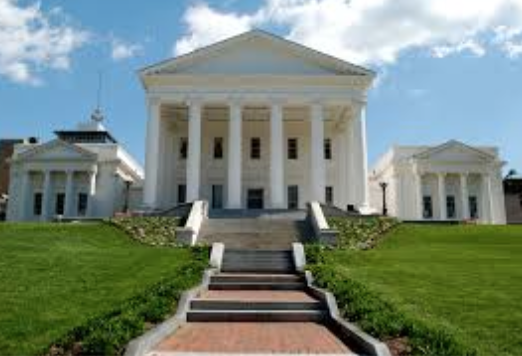


 businesses and activities both directly and indirectly related to the clean energy sector. It was expanded in 2013 to also include South Carolina, Georgia, and Virginia, allowing for a more comprehensive picture of the energy economy of the Southeast. The Virginia Energy Efficiency Council is responsible for the Virginia portion of the census, and has expanded the list to include all businesses that operate within the energy efficiency sector.
businesses and activities both directly and indirectly related to the clean energy sector. It was expanded in 2013 to also include South Carolina, Georgia, and Virginia, allowing for a more comprehensive picture of the energy economy of the Southeast. The Virginia Energy Efficiency Council is responsible for the Virginia portion of the census, and has expanded the list to include all businesses that operate within the energy efficiency sector. All businesses will be sent a survey via email, which is conducted in complete confidentiality in order to receive the most accurate and direct responses possible. In the survey, each business will be asked questions regarding company details (e.g., name, address, primary contact), clean energy activities performed, clean energy sectors in which the business is active, revenue, full-time jobs offered by the clean energy activity/sector, and areas in which the company does business. The survey is considered complete if businesses include responses to all of the aforementioned topics. The survey will be posted online, and will be open through September 20, 2016. If we haven’t heard back from your company, you will be contacted by phone in June and July by an outside contractor, and follow-up interviews with non-respondents will be conducted in September. The survey, based on a sample pool of approximately 3,800 firms, aims to obtain a minimum of 1,600 completions by phone or online.
All businesses will be sent a survey via email, which is conducted in complete confidentiality in order to receive the most accurate and direct responses possible. In the survey, each business will be asked questions regarding company details (e.g., name, address, primary contact), clean energy activities performed, clean energy sectors in which the business is active, revenue, full-time jobs offered by the clean energy activity/sector, and areas in which the company does business. The survey is considered complete if businesses include responses to all of the aforementioned topics. The survey will be posted online, and will be open through September 20, 2016. If we haven’t heard back from your company, you will be contacted by phone in June and July by an outside contractor, and follow-up interviews with non-respondents will be conducted in September. The survey, based on a sample pool of approximately 3,800 firms, aims to obtain a minimum of 1,600 completions by phone or online. 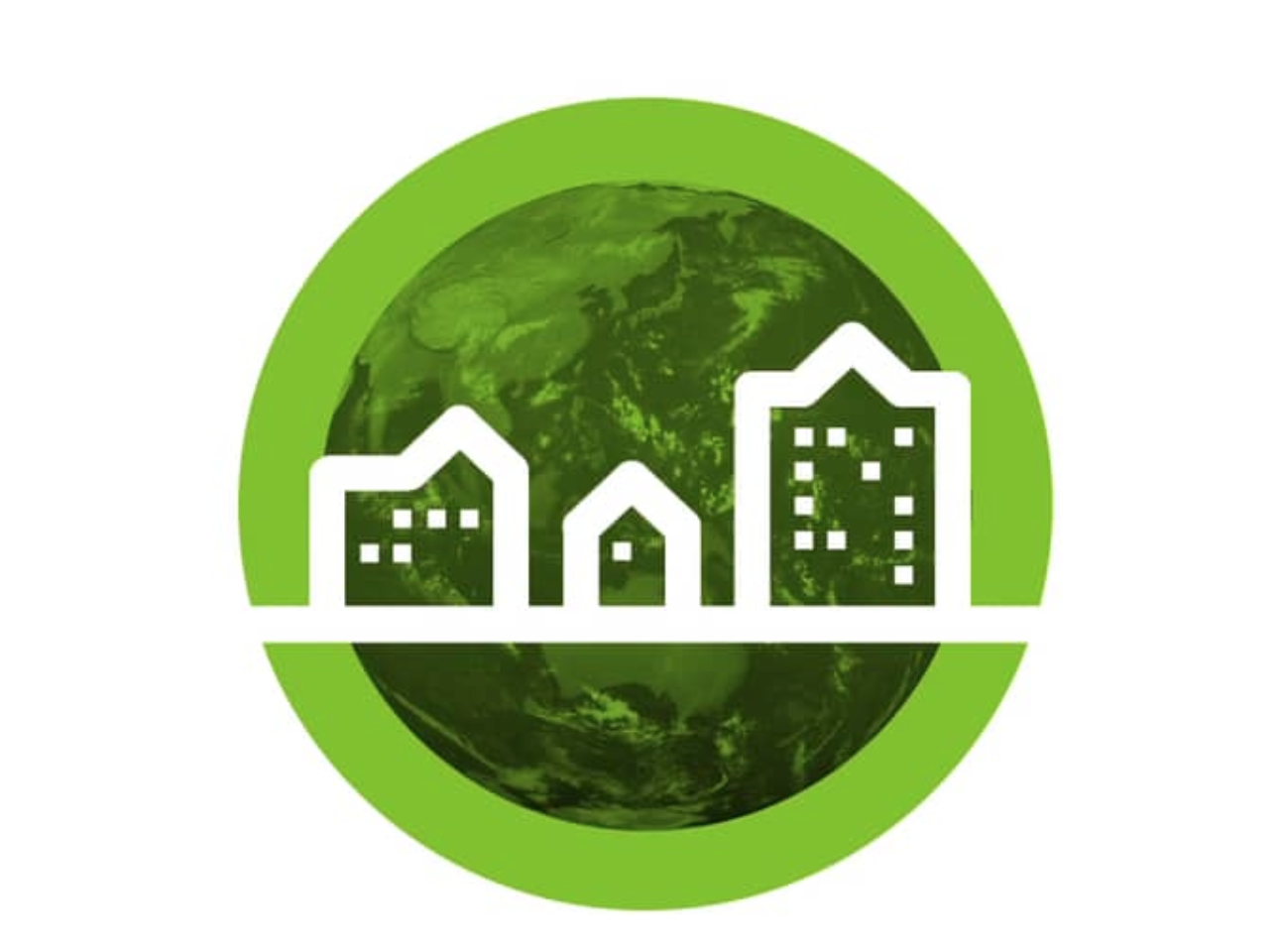
 Guest Post by: Stuart Nuckols, Viridiant (Associate Member)
Guest Post by: Stuart Nuckols, Viridiant (Associate Member)

 Find out how their new name embodies the vision for their organization in
Find out how their new name embodies the vision for their organization in 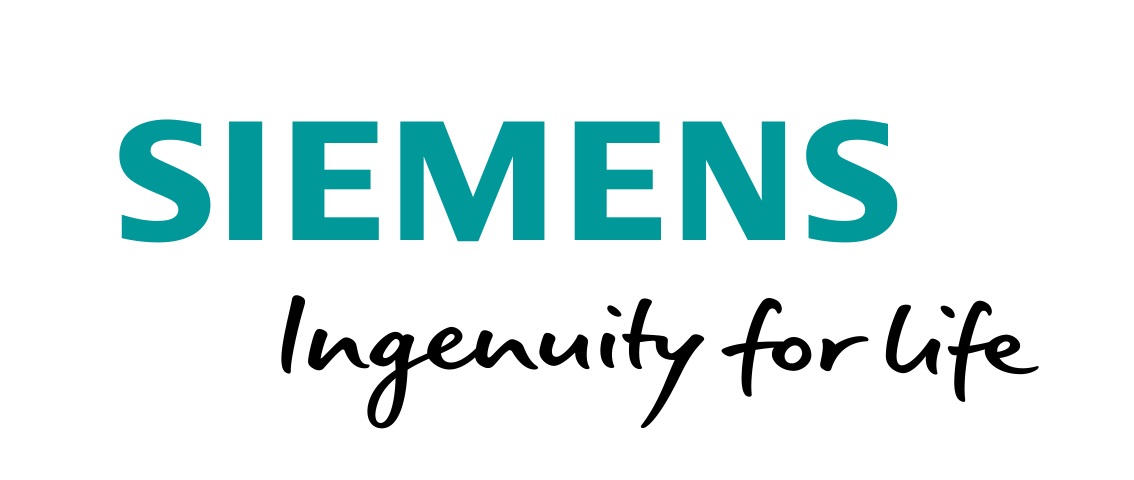
 For over 165 years,
For over 165 years, 
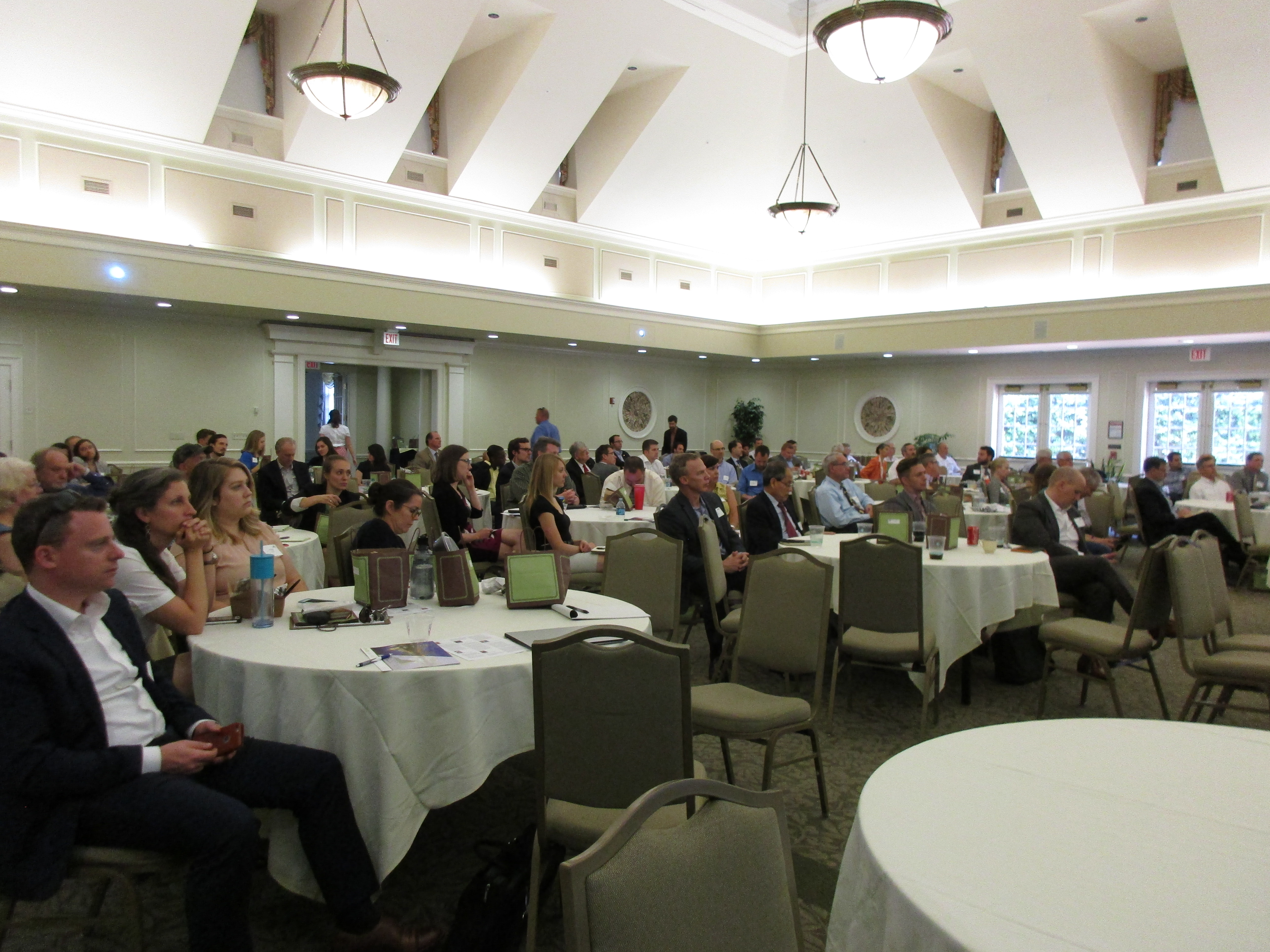

 gave an update on the 2016 General Assembly session and the work of the Governor’s Executive Committee on Energy Efficiency (GEC). Hayes told the crowded room about SB 395 and HB 1053, which were bills the Governor initiated. The final outcome for these bills, which wasn’t the initially hoped for outcome (
gave an update on the 2016 General Assembly session and the work of the Governor’s Executive Committee on Energy Efficiency (GEC). Hayes told the crowded room about SB 395 and HB 1053, which were bills the Governor initiated. The final outcome for these bills, which wasn’t the initially hoped for outcome ( three more presentations. First was Ryan Hodum with David Gardiner & Associates — also our newest member! Ryan presented on two of DGA’s initiatives:
three more presentations. First was Ryan Hodum with David Gardiner & Associates — also our newest member! Ryan presented on two of DGA’s initiatives:  We spent the last 30 minutes of the meeting giving our members the opportunity to brag a little bit. A microphone was sent around for members to give a 2-3 minute update on anything they are working on related to energy efficiency. Dominion Virginia Power, Columbia Gas and Washington Gas all gave updates on their energy efficiency programs and their latest proceedings before the SCC. Several other members gave updates as well including Trane, Viridant, Virginia Community Capital, and Loudon County Public Schools. We are pleased that so many members chimed in to talk about their work.
We spent the last 30 minutes of the meeting giving our members the opportunity to brag a little bit. A microphone was sent around for members to give a 2-3 minute update on anything they are working on related to energy efficiency. Dominion Virginia Power, Columbia Gas and Washington Gas all gave updates on their energy efficiency programs and their latest proceedings before the SCC. Several other members gave updates as well including Trane, Viridant, Virginia Community Capital, and Loudon County Public Schools. We are pleased that so many members chimed in to talk about their work.



